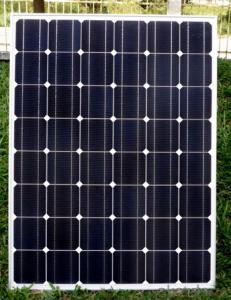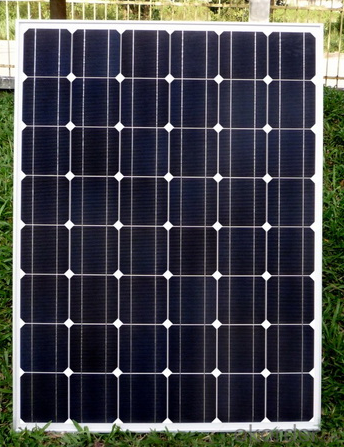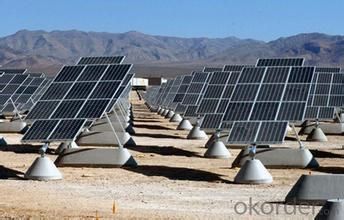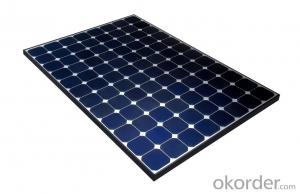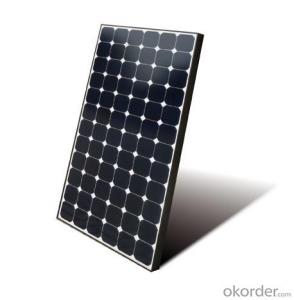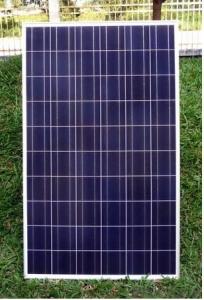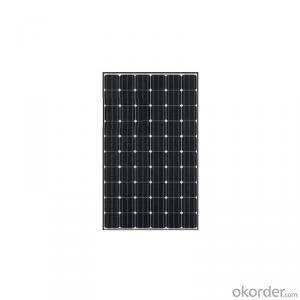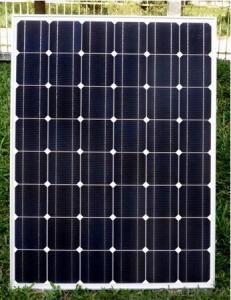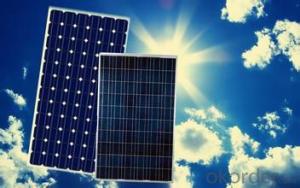Q-Cell A-Grade Mono Solar Panel 70W Cheapest Price
- Loading Port:
- Tianjin
- Payment Terms:
- TT OR LC
- Min Order Qty:
- 100 watt
- Supply Capability:
- 1000 watt/month
OKorder Service Pledge
OKorder Financial Service
You Might Also Like
Specification
Mono Solar Panel 70W A Grade with Cheapest Price
product description
Strings of series cells are usually handled independently and not connected in parallel, though as of 2014)individual power boxes are often supplied for each module, and are connected in parallel. Although modules can be interconnected to create an array with the desired peak DC voltage and loading current capacity, using independent MPPTs (maximum power point trackers) is preferable. Otherwise, shunt diodes can reduce shadowing power loss in arrays with series/parallel connected cells.[citation needed]
A photovoltaic (in short PV) module is a packaged, connected assembly of typically 6×10 solar cells. Solar Photovoltaic panels constitute the solar array of a photovoltaic system that generates and supplies solar electricity in commercial and residential applications. Each module is rated by its DC output power under standard test conditions, and typically ranges from 100 to 365 watts. The efficiency of a module determines the area of a module given the same rated output – an 8% efficient 230 watt module will have twice the area of a 16% efficient 230 watt module. There are a few solar panels available that are exceeding 19% efficiency. A single solar module can produce only a limited amount of power; most installations contain multiple modules. A photovoltaic system typically includes a panel or an array of solar modules, a solar inverter, and sometimes a battery and/or solar tracker and interconnection wiring.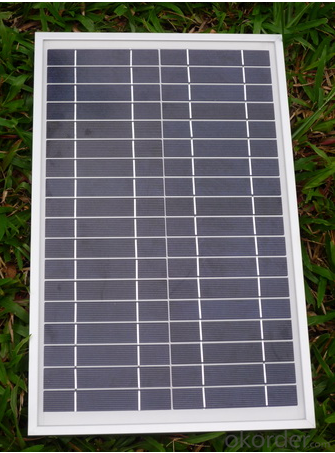
Feature
The modules use high-quality imported polycrystalline or Polycrystalline solar panel;
Enclosed by high-rigidity tempered glass, with excellent light transmittance and output performance;
Surface treated with reflection-reducing process, increasing the light absorption.
Back sealed with anti-aging EVA, resistant from moisture and corrosion.
The efficiency of our Polycrystalline solar cell is over 17%, and polycrystalline panel is over 16%. We stipulate, the allowance of each panel’s rated power has to be positive. Each panel is strictly tested before leaving the factory.
Our solar panel is designed with a lifetime of 25 years, and guaranteed that the power decline less than 10% within 10 years, and 20% within 20 years.
Packaging
28pcs into one box 48pcs into one pallet.
Delivery
20 days after received full payment
Payment term
LC&TT
- Q: Can solar panels be installed on theme parks or amusement parks?
- Yes, solar panels can be installed on theme parks or amusement parks. In fact, many parks are increasingly embracing renewable energy sources like solar power to reduce their carbon footprint and energy costs. Installing solar panels on theme parks can not only provide clean and sustainable energy but also serve as a visible demonstration of their commitment to environmental sustainability.
- Q: My house is aligned exactly North-South, so I have no roof facing South. Is it worth installing solar panels? Are there any good options for dealing with this situation?
- In your case you will need twice as many panels. This is because the panels on the west side of the roof will be in shade in the morning and the panels on the east side of the roof will be in shade in the afternoon, and a solar panel in the shade makes no power, or at least very little power. So right there you doubled the cost of an already too expensive system. Or you could build special stands to hold the panels facing south. It would be cheaper to just move to a house with better alignment!
- Q: Hi there. I live in Colorado, and we obviously get a ton of snow there. I im looking into a solar power system for my home, and I am wondering if the snow will accumulate on the panels, or if, because of the energy passing through, it will melt on contact? By the way we get about 20' of snow each year, and it comes on often. I will also be putting them on my roof. Thanks for your help.
- Good news and not so good news. You need to be able to access the panels to clean the snow off. There is not any heat generated other than the heat of the sun hitting the black colour - which would amount to some melting ability during a sunny day - but it isn't sunny when it snows! Apparently, solar panels work better in the cold and where snow can reflect light so to increase the amount of light - photons - hitting the panel.
- Q: Can solar panels be installed on a rented property?
- Yes, solar panels can be installed on a rented property. However, it is important to consult with the landlord and review the lease agreement to ensure that the installation is allowed. In some cases, the landlord may require written permission or may be responsible for the installation process. Additionally, it is recommended to discuss the potential benefits and cost savings of installing solar panels with the landlord to determine if it is a viable option for both parties.
- Q: I have an electric bicycle that I travel to work by, pulling a modified child carrying trailer that holds two 2 volt deep cycle batteries in series to power the 24 volt bike motor. I'm thinking about adding a 50 watt solar panel (or larger depending on the room I can make available) to charge while I'm at work and to provide some extra juice while on my more distant travels.Can I get a solar panel to charge them while they're connected the way they are: in series? Does charging work that way?I've read that in order to charge the 24 volt battery setup (if the answer to the Q above is yes), the output from my solar panel would need to be a little more than 24 volts. Is this true? If so, how many volts?Since the bike is supposed to be powered at 24 volts and I have an x-volt (x gt; 24v) solar panel connected to it, will this cause any damage to the controller or other components while running them?Will it help supply power even while the motor is being run?Thanks.
- Charging voltage = 2*3.8 = 27.6V Current regulated to AH rating divided by 0 Charging time = 0 hours
- Q: Do solar panels require permits for installation?
- Yes, in most cases, solar panels require permits for installation. The specific requirements and regulations vary depending on the location, but obtaining permits ensures that the installation meets safety standards and compliance regulations set by local authorities.
- Q: Can solar panels be used in areas with high wind speeds?
- Yes, solar panels can be used in areas with high wind speeds. However, it is important to ensure that the solar panel installation is designed and engineered to withstand the specific wind conditions in the area. This may involve using specialized mounting systems and ensuring proper anchoring and structural reinforcement to prevent damage or dislodgement due to strong winds.
- Q: quot;Does it take more energy to produce a solar panel than what the same solar panel can generate in its useful lifetime?quot;
- Thor is right and wrong. Solar panel will produce more than they take to make. My solar panels only have a 0 year estimated useful life. They may actually last longer, but with time they lose efficiency. Here in Phoenix where the sun shines all the time, a decent solar system you purchase and pay to have installed will pay back the original investment in 5-20 years. If you are a handyman and can install it yourself it will pay back sooner. Solar is a great system for reducing CO2 pollution, but until grid power rates increase a lot, it is still not very cost effective in most areas. It is also a myth that anyone can just install a solar system and get off grid power. Most people could not afford it, and most people would not like not having heat or air. Any system that normal people could afford could not supply anywhere near enough power for heating or air conditioning.
- Q: what percentage of sunlight is converted into electrical energy in a solar panel?
- Around 20%
- Q: Okay, me and my friends are going to fix up an old trailer that's out in the woods, we want something to be able to run small electric appliances off of, but it's to far to run power to. How can we make a good but cheap homemade solar panel that we could plug things into? The trailer is in more of a field so it gets plenty of sunlight! Thanks for any help! :)
- you cant make solar panels to generate electricity at home. A LOT of high tech equipment is needed. About the cheapest option is to use solar powered garden lights but that is all you'll get is a bit of light.(Google making solar panels) You should be able to make up a windmill powered generator though (but dont expect much power out of something you can make easily) Do some research yourself
Send your message to us
Q-Cell A-Grade Mono Solar Panel 70W Cheapest Price
- Loading Port:
- Tianjin
- Payment Terms:
- TT OR LC
- Min Order Qty:
- 100 watt
- Supply Capability:
- 1000 watt/month
OKorder Service Pledge
OKorder Financial Service
Similar products
Hot products
Hot Searches
Related keywords
